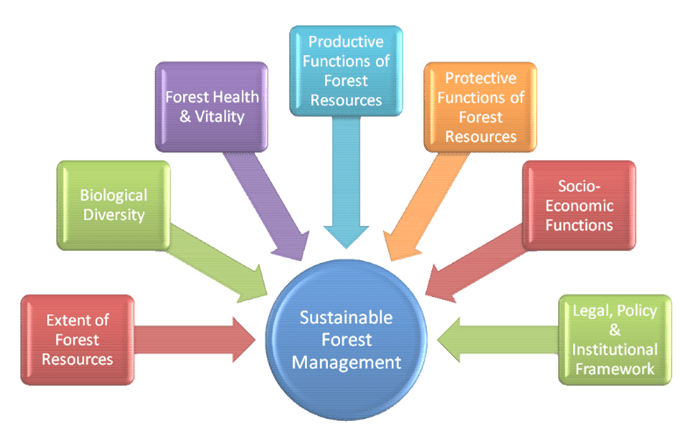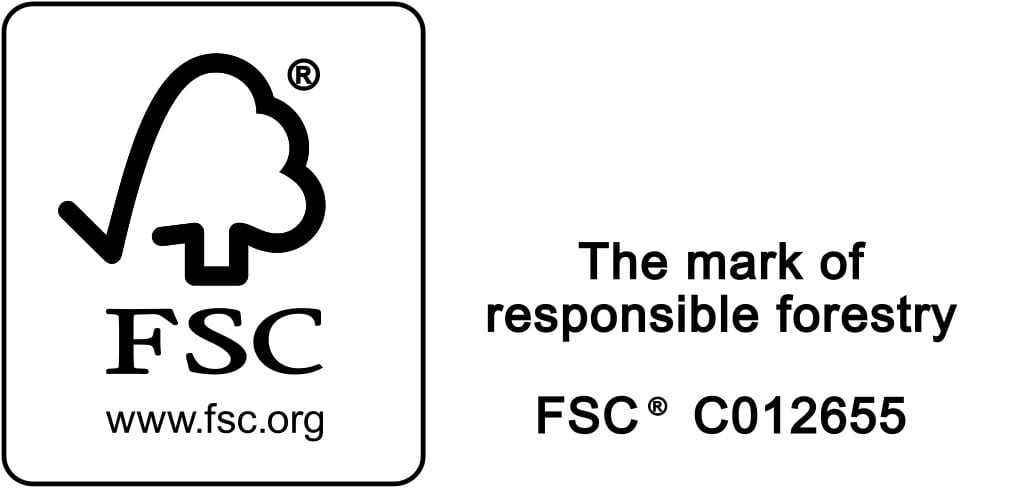*based on our experience and satisfaction with FSC® and PEFC.
9Wood offers designers certified wood ceilings through two certification programs: FSC® (Forest Stewardship Council®) and PEFC (Programme for the Endorsement of Forest Certification). Both programs offer certified wood that qualifies for LEED credits. (See also 9Wood’s Journey supplying certified wood.)
Before looking at these programs, it is helpful to review their purpose: to promote well-managed forestry.
Sustainable Forest Management
The United Nations defines Sustainable Forest Management (SFM) as:
The stewardship and use of forests and forest lands in a way, and at a rate, that maintains their biodiversity, productivity, regeneration capacity, vitality and their potential to fulfill, now and in the future, relevant ecological, economic and social functions, at local, national, and global levels, and that does not cause damage to other ecosystems. (per FAO; the UN Food and Agriculture Organization)
In simple terms SFM is a stool balanced on three legs: social, economic and environmental, designed to deliver better outcomes for forests.
There is a growing international consensus on the key elements of SFM. Seven thematic areas have emerged:

Certifying Organizations
To activate these principles on-the-ground, organizations were needed to certify forest operators were actually practicing sustainable forestry. The basic requirements of a credible forest certification program include:
- Principles and criteria that defend Sustainable Forest Management thematic areas:
- Protection of biodiversity, species at risk and wildlife habitat.
- Forest health at sustainable harvest levels.
- Protection of water quality.
- Prompt regeneration (e.g., replanting and reforestation).
- Protection for local economies and indigenous peoples.
- Third-party certification audits performed by accredited certification bodies.
- Publicly available and transparent certification audit summaries.
- Multi-stakeholder involvement in a standards development process.
- A complaints and appeals process.
The largest certifying organizations are global, providing a system for voluntary accreditation and independent third-party certification. These NGOs are designed to be market driven, not government mandated. The idea is that consumers choosing to purchase certified wood over non-certified will motivate forest stakeholders to expand forest certification—and well-managed forestry will flourish. Certification organizations allow certificate holders to market their wood products using the organization’s eco-label, signaling the consumer the wood product in view originated from well-managed, sustainable forests.
Certifying organizations drafted, and regularly update, defined forestry standards. Each organization has its own standards, typically divided into Principles, Objectives and Criteria. PEFC, for example, has a series of 14 Principles, 38 Objectives and 101 Criteria that cover the thematic areas of Sustainable Forest Management. Ten general principles summarize FSC’s basic criteria for a well-managed forest. These are typically long and detailed documents, which can be found on the organization’s website.
There are two types of certification: Forest Management (for landowners, who grow the trees) and Chain-of-Custody (for suppliers and manufacturers, who use the harvested trees). In both types of certification, independent accredited Certification Bodies (“certifiers” like Scientific Certification Services) inspect and verify the certificate-holding landowners and suppliers (also known as operators) comply with the standards established by the certifying organization. Chain-of-Custody verifies that supply chain members can effectively identify and keep harvested certified wood separate throughout their operations all the way to the end user. 9Wood is accredited as both an FSC and PEFC Chain-of-Custody manufacturer by Scientific Certification Systems.
The critique against the certification movement is the claim that forest certification can never be implemented effectively. Why? Because every accredited certifier, such as SCS (Scientific Certification Systems) is hired by the company seeking its own certification. SCS, for example, audits 9Wood per FSC and PEFC standards. But 9Wood also pays for this privilege. Environmentalists claim this is an insurmountable moral hazard. Notwithstanding, the largest certification programs welcome—explicitly—market forces, as well as social and environmental, into the process. This controversy has not been resolved as no alternative mechanism for funding certification has been found.
There are more than 50 certification programs worldwide addressing many types of forests and contexts. FSC and PEFC are the two largest certification organizations; the two accreditations 9Wood has obtained.
Forest Stewardship Council®
The Forest Stewardship Council (FSC) is an international non-profit, multi-stakeholder organization based in Bonn, Germany. It was established in 1993 following the Rio Earth Summit to promote responsible management of the world’s forests, particularly in tropical forests. FSC does this by setting standards on forest products, along with certifying and labeling them as eco-friendly.

“Promote environmentally appropriate, socially beneficial and economically viable management of the world’s forests.”
FSC’s mission is to:
Because it deliberately works outside of government regulations, FSC is classified as an example of a Non-State Market Driven form of environmental governance. [This means that it uses the market to drive sustainable forest management. The FSC network does not have the political authority of a traditional nation. After all, no one can be fined or imprisoned for failing to comply with its regulations. In fact, governments are expressly forbidden from being members of the FSC. Their only engagement with FSC is as landowners. The authority of the FSC is determined by the approval of external audiences, such as environmental NGOs (Non-Governmental Organizations). The market has a large voice, as do environmental lobbies.
Criticism of FSC Greenpeace International was a founding member of the Forest Stewardship Council (FSC), recently decided not to renew its FSC membership due to what they believe are inconsistent implementation and failures to protect forests.
The need for operators to maintain dual certification, PEFC and FSC, is still another critique. Over the past ten years, FSC has pushed into paper certification. Targeting the ‘green-brand’ needs of a few large pulp and paper companies like Kimberly Clark became an intermediate goal of FSC in North America. This was an easier path to FSC’s ultimate goal of wider market recognition. The harder path was influencing hundreds of individual timber firms to adopt FSC certification. Success with these pulp companies created a large demand of FSC certified Canadian forests.
But not in British Columbia. Because of its natural forest makeup of species—specifically coniferous softwoods like Hemlock and Douglas fir–it is a lumber, not a pulp driven market. For these BC firms, maintaining dual certification, FSC and PEFC, made less and less sense as no price advantage seemed to materialize to cover their added expenses. So, many BC firms dropped their FSC certification, which made the supply of FSC softwood lumber more difficult to come by and therefore more expensive.
The Programme for the Endorsement of Forest Certification (PEFC)
Like FSC, PEFC is an international non-profit, non-governmental organization dedicated to promoting Sustainable Forest Management (SFM) through independent third-party certification. Based in Geneva, Switzerland, its globally established standards seek to transform the way forests are managed globally—and locally—to ensure that environmental, social and economic benefits that forests offer are most widely enjoyed.

PEFC differs from FSC in that it is an umbrella organization. This means it endorses national forest certification systems. These national certification systems are developed through multi-stakeholder processes and tailored to local priorities and conditions. 9Wood’s Canadian softwood is certified by PEFC through the Canadian Standards Association Group. Unlike FSC, PEFC is not opposed to government participation in its organization and its benchmarks.
Each national forest certification system undergoes rigorous third-party assessment against the PEFC Sustainability Benchmarks to ensure consistency with international requirements. Then they can earn PEFC certification.
Like FSC, PEFC has a series of Principles, Objectives and Criteria that cover the thematic areas of Sustainable Forest Management. PEFC also has its own eco-label and a Chain-of-Custody system.
Forty-two national certification systems are currently endorsed and around 300 million forest hectares certified. This makes PEFC the world’s largest forest certification system.
How does the umbrella concept work?
PEFC sustainable forest management benchmarks have been developed based on internationally recognized, ongoing and long term, intergovernmental processes and guidelines for the promotion of sustainable forest management to ensure compliance with globally agreed requirements.
The benchmark criteria are regularly revised through multi-stakeholder processes involving participants drawn globally from civil society, business, governments, labor and research institutions to take account of new scientific knowledge, societal change, evolving expectations and to incorporate latest best practice.
In 2015 the World Wildlife Fund, one of the founding members of the Forest Stewardship Council in 1993, formally endorsed PEFC. They deployed their WWF Certification Assessment Tool (CAT) to methodically evaluate and compare certification systems as they compare with WWF’s own mission and objectives for environmental protection.
Criticism of PEFC
Though WWF endorsement was a major milestone for PEFC, the WWF assessed FSC as the “stronger system, providing the most credible forest certification scheme at present.’
Other environmental groups call PEFC a certification by the timber industry, for the timber industry, minus the social and environmental chambers. And of course, Greenpeace’s critique of FSC applies to PEFC.
How do we make sense of the controversies?
9Wood believes, despite its imperfections, the ‘3-legged stool’ is the most practical model to improve world forestry. All three legs, the social, economic and environmental, with their necessary tensions, need a voice at the certification table. After all, no certification program endorses illegal logging or endangered species violations. The challenge is delivering real, positive impact on the ground where the standards must be applied.
Market forces such as the LEED program and its endorsement of multiple certifications, are driving higher demand of certified wood. From a practical standpoint, offering dual certifications allows 9Wood to meet this growing customer demand. From a values standpoint, supplying designers with ceilings using FSC and PEFC certified wood, as well as the LEED credits that can be obtained through our dual Chain-of-Custody accreditation, is 9Wood’s contribution to supporting well-managed forestry and the growth of certified forests worldwide.
